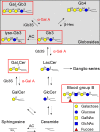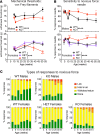Neuropathic pain in a Fabry disease rat model
- PMID: 29563343
- PMCID: PMC5926911
- DOI: 10.1172/jci.insight.99171
Neuropathic pain in a Fabry disease rat model
Abstract
Fabry disease, the most common lysosomal storage disease, affects multiple organs and results in a shortened life span. This disease is caused by a deficiency of the lysosomal enzyme α-galactosidase A, which leads to glycosphingolipid accumulation in many cell types. Neuropathic pain is an early and severely debilitating symptom in patients with Fabry disease, but the cellular and molecular mechanisms that cause the pain are unknown. We generated a rat model of Fabry disease, the first nonmouse model to our knowledge. Fabry rats had substantial serum and tissue accumulation of α-galactosyl glycosphingolipids and had pronounced mechanical pain behavior. Additionally, Fabry rat dorsal root ganglia displayed global N-glycan alterations, sensory neurons were laden with inclusions, and sensory neuron somata exhibited prominent sensitization to mechanical force. We found that the cation channel transient receptor potential ankyrin 1 (TRPA1) is sensitized in Fabry rat sensory neurons and that TRPA1 antagonism reversed the behavioral mechanical sensitization. This study points toward TRPA1 as a potentially novel target to treat the pain experienced by patients with Fabry disease.
Keywords: Genetic diseases; Glycobiology; Neuroscience; Pain.
Conflict of interest statement
Figures










Similar articles
-
Satellite glial cells in sensory ganglia express functional transient receptor potential ankyrin 1 that is sensitized in neuropathic and inflammatory pain.Mol Pain. 2020 Jan-Dec;16:1744806920925425. doi: 10.1177/1744806920925425. Mol Pain. 2020. PMID: 32484015 Free PMC article.
-
α-Galactosidase A-deficient rats accumulate glycosphingolipids and develop cardiorenal phenotypes of Fabry disease.FASEB J. 2019 Jan;33(1):418-429. doi: 10.1096/fj.201800771R. Epub 2018 Jul 6. FASEB J. 2019. PMID: 29979634 Free PMC article.
-
Rats deficient in α-galactosidase A develop ocular manifestations of Fabry disease.Sci Rep. 2019 Jun 28;9(1):9392. doi: 10.1038/s41598-019-45837-1. Sci Rep. 2019. PMID: 31253878 Free PMC article.
-
Fabry disease pain: patient and preclinical parallels.Pain. 2021 May 1;162(5):1305-1321. doi: 10.1097/j.pain.0000000000002152. Pain. 2021. PMID: 33259456 Free PMC article. Review.
-
Ion channels and pain in Fabry disease.Mol Pain. 2021 Jan-Dec;17:17448069211033172. doi: 10.1177/17448069211033172. Mol Pain. 2021. PMID: 34284652 Free PMC article. Review.
Cited by
-
Advances in Sphingolipidoses: CRISPR-Cas9 Editing as an Option for Modelling and Therapy.Int J Mol Sci. 2019 Nov 24;20(23):5897. doi: 10.3390/ijms20235897. Int J Mol Sci. 2019. PMID: 31771289 Free PMC article. Review.
-
Sensory-specific peripheral nerve pathology in a rat model of Fabry disease.Neurobiol Pain. 2021 Sep 2;10:100074. doi: 10.1016/j.ynpai.2021.100074. eCollection 2021 Aug-Dec. Neurobiol Pain. 2021. PMID: 34541380 Free PMC article.
-
Auditory brainstem responses in aging dark agouti rats.Biosci Rep. 2021 Feb 26;41(2):BSR20202724. doi: 10.1042/BSR20202724. Biosci Rep. 2021. PMID: 33506259 Free PMC article.
-
Elevated interleukin-8 expression by skin fibroblasts as a potential contributor to pain in women with Fabry disease.PLoS One. 2024 Apr 9;19(4):e0300687. doi: 10.1371/journal.pone.0300687. eCollection 2024. PLoS One. 2024. PMID: 38593151 Free PMC article.
-
Assessing the role of glycosphingolipids in the phenotype severity of Fabry disease mouse model.J Lipid Res. 2020 Nov;61(11):1410-1423. doi: 10.1194/jlr.RA120000909. Epub 2020 Aug 31. J Lipid Res. 2020. PMID: 32868283 Free PMC article.
References
Publication types
MeSH terms
Substances
Grants and funding
LinkOut - more resources
Full Text Sources
Other Literature Sources
Medical
Research Materials

